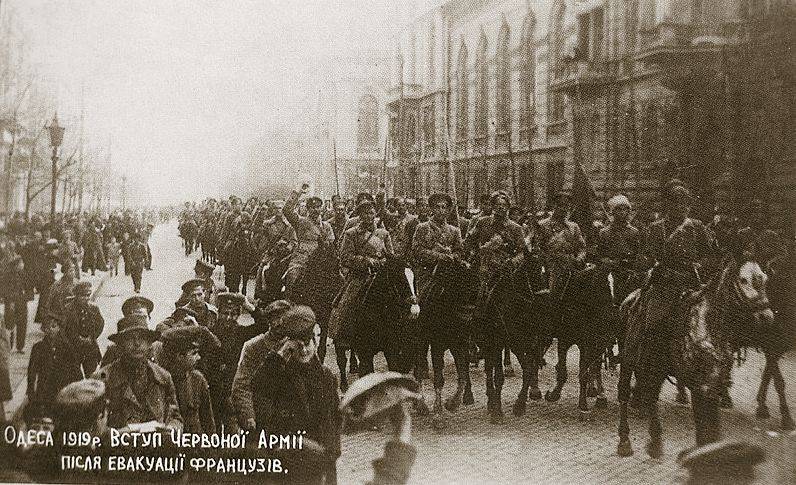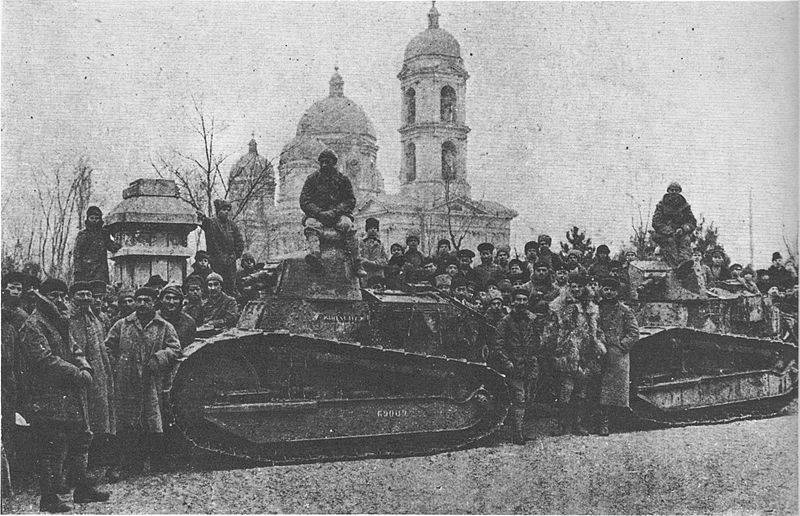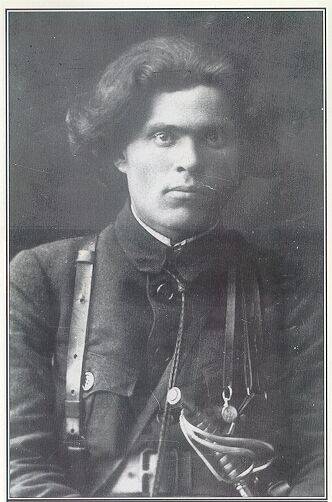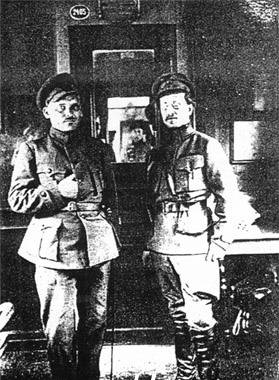How defeated Petliurism
Soviet offensive and defeat of the Directory
The defeat of Germany in the world war allowed the Soviet government to break the Brest agreement. In November, 1918, Moscow decided to restore Soviet power in the Ukraine to Ukraine. All the prerequisites for this were - the West Russian population for the most part tasted all the “charms” of the Austro-German occupation regime, the Hetman and the Directory. Ukraine was rapidly turning into a “wild field”, where the law of force, all sorts of chieftains and daddies ruled. The peasantry responded to the violence and injustice with their war. The Ukrainian peasant war became an important part of the all-Russian peasant war. Western and southern Russian regions are in turmoil, anarchy. In fact, the power of the Directory to the beginning of the Soviet offensive was limited to the Kiev district, then ruled by atamans. However, some, like Grigorieva and Makhno created entire armies.
Therefore, the offensive of the Red Army was immediately supported not only by the Bolsheviks, but also by a large part of the peasants, who hoped for a final solution of the land question in their favor and for the cessation of violence, looting and restoration of order. In December, 1918, the 1 and 2, the Ukrainian Insurgent Divisions (formed in September, 1918) launched an offensive. 1 - January 2 The 1919 of the year at the Cossack Lopani Red broke Zaporozhye Corps Bolbochan. January 3 1919, with the support of local rebels, the Ukrainian Soviet Army, under the command of V. Antonov-Ovseenko, liberated Kharkov. The Provisional Workers 'and Peasants' Government of Ukraine is located here.
4 January 1919 of the Year The Revolutionary Military Council of the Republic (RVS, RVSR) based on the forces of the Ukrainian Soviet Army formed the Ukrainian Front (UV), headed by Antonov-Ovseenko. The core of the UV was the 9-I infantry division from the 8 Red Army, the 1-I and 2-I Ukrainian Soviet divisions. Also in the front included individual rifle and cavalry units, border guards, international detachments and armored trains. 27 January 1919 was created Kharkiv Military District, which was to form and prepare parts for the Ukrainian front.
UV began to move to the Donbass, where, in conjunction with the Southern Front, was to fight in the whites. For the liberation of Left-Bank Ukraine, the Middle Dnieper region, only one brigade of the 9 division and local partisans was planned to use reconnaissance on the Black Sea coast. Right Bank Ukraine is not going to touch. If the power of the Directory were stable, and it could create a strong army, the Reds concentrated their efforts in the struggle against the Whites and Kiev could stand aside for a while. But a wave of uprisings and a massive shift to the side of the red local rebel and partisan detachments rejected the main direction of the advance of the UF to the west. The front troops launched an offensive in two directions: 1) on Kiev and Cherkasy; 2) Poltava and Lozovaya, later to Odessa. Later, in April 1919, the 1-i, 2-i and 3-I Ukrainian Soviet armies were formed as part of the UF. 1-I army fought in the Kiev direction, cleared from the enemy the territory of Western Ukraine. The 2 Army operated in a southerly direction, liberated Odessa and the Crimea, and fought against Denikin. 3-I army acted on the Odessa direction, in Transnistria.
16 January 1919, the directory declared war on Soviet Russia. The commander-in-chief of the UNR forces Petlyura created the Left-Bank Front (Eastern Front) under the command of Bolbochan, the Right-Bank Front of Shapoval and the Southern Group of Forces Guly-Gulenko. At the same time, Bolbochan surrendered Poltava. Attempt Petliurists repel the city did not lead to success. By the order of Petliura, Bolbochan was removed from command and sent to Kiev, where he was accused of surrendering Kharkiv and Poltava, treason (intending to go over to the side of whites) and embezzlement. The Eastern Front of the Directory was headed by Konovalets. This did not help the Petliurists. Their front collapsed due to numerous uprisings in the rear, the transfer of field commanders (atamans) to the Reds. In essence, the UNR troops (they were based on various detachments of field commanders and atamans) went over to the Reds. These detachments in full force with their commanders were part of the Soviet forces, receiving a number, official name, supply and commissars (this later had a negative effect on the Red Army itself - discipline and organization plummeted, numerous riots and atrocities began, etc. ). 26 January 1919, the Red Army took Yekaterinoslav.
In the context of a military catastrophe, the Directory attempted to negotiate simultaneously with Moscow (Mazurenko’s mission) and the command of the Entente in Odessa (General Grekov). Negotiations with Mazurenko began on January 17. The Soviet government represented Manuilsky. Mazurenko tried to find a compromise between the left wing of the Directory and the Bolsheviks at the expense of the military wing of the UPR (Petliurists). The Soviet side proposed the "mediation" of the RSFSR between the UNR and the Soviet Ukraine in order to achieve a truce. In Ukraine, the Congress of Soviets was to be convened on the principles adopted in Soviet Russia, and the UNR troops were to take part in the struggle against the White Army and the interventionists. 1 February the Soviet side somewhat softened the conditions: 1) The directory recognized the principle of the power of the Soviets in Ukraine; 2) Ukraine remained neutral, with active self-defense against all foreign interference; 3) joint struggle against the forces of counter-revolution; 4) truce during peace negotiations. Mazurenko accepted these conditions.
The directory found out about this February 9. Vinnichenko proposed, as in November-December 1918 of the year, to proclaim his Soviet power. However, in the conditions of the successful offensive of the Red Army, the collapse of the UPR army, Moscow could not accept such conditions. Soviet troops successfully crossed the Dnieper and February 5 of the year 1919 occupied Kiev. Directory fled to Vinnitsa.
The Petliurists decided to bet on the Entente. That is, they repeated the path of the Central Rada and the Hetmanate of Skoropadsky, who hoped for help from the Central Powers (Germany and Austria-Hungary). The problem was that the French command in the person of General Philip D'Anselm and his chief of staff Freidenberg stated that they had come to Russia "in order to give all trustworthy elements and patriots to restore order in the country", destroyed by the horrors of civil war. And the volunteers (whites), not the Ukrainian nationalists, were considered patriots of Russia. The French considered Ukraine a part of Russia and the Directory could at best claim the status of a part of the future Russian government. Under the guise of foreign invaders in Odessa, a military administration of whites was created, headed by General A. Grishin-Almazov. Previously, he led the white forces in Siberia, but quarreled with the local socialist leadership and went to the South of Russia at the disposal of General Denikin. In Odessa, planned to form the South Russian army. At the beginning of 1919, General N. Timanovsky arrived in Odessa on the instructions of Denikin. But the formation of the white army went slowly because of the opposition of the French occupation authorities and the departure of officers to the area of the location of the Volunteer Army.
Under the conditions of the Soviet offensive and the uncompromising white command, the French command accepted the mission of General Grekov and refused to focus on Denikin’s army (his French considered the British figure). D'Anselm demanded that the Directory release a significant bridgehead in the south of Little Russia to supply Odessa and the interventionist army. The directory accepted this requirement as a condition for the start of further negotiations. The interventionists occupied Kherson and Nikolaev, and in the area of the mouth of the Dnieper united with the Whites (the Crimean-Azov Army). True, the concessions to the interventionists from the Directorate caused the ire of ataman Grigoriev, who considered himself the owner of the Kherson-Nikolaev area, and soon he and his rebel army switched to the Reds.
Next, the French put the political conditions of the Directory: the elimination of left-wing forces from the government; giving them control over the railways and finances of Ukraine; the implementation of agrarian reform on the principles of remuneration of the owner of the land, and the preservation of private ownership of small and medium-sized estates; the creation of a united anti-Bolshevik front under the French command and the formation of mixed French-Ukrainian and French-Russian units; the occupation of the entire South of Russia by French troops; power directory maintained only in the civil sphere. In early February, 1919, the Directory refused to accept this crude ultimatum, but continued negotiations. Prime Minister Ostapenko urged the Entente to recognize the UPR and help in the fight against the Bolsheviks. The Ukrainian delegation did the same at the Paris Conference, but without success.
In the conditions of a successful offensive of the Reds and the collapse of the front, the interventionists for the Directory remained the last hope. February 9 Ukrainian Social Democrats withdrew their representatives from the Directory. "Almost Bolshevik" Vinnichenko left the Directory and soon went abroad. Even there, he retained the view that Kiev’s agreement with Moscow on a Soviet basis is the most unique and acceptable option for the development of Ukrainian-Russian relations and the development of a common revolutionary process. And the Directory, in fact, became the wandering headquarters of Supreme Ataman Petlyura, who left USDRP and tore up with his socialist past. Directory Mode finally acquired a national-authoritarian character.
True, this did not help the Directory. England and France preferred to support Denikin and Kolchak, and they adhered to the idea of "united and indivisible Russia." In addition, in the early spring of 1919, the Entente command finally decided not to engage in large-scale hostilities in Russia. The masters of the West preferred to set off Russians with Russians. And in the area of Odessa it was not possible to form an efficient army of Russians, in order to put it against the Reds. In addition, the disruption of the troops of the interventionists began, the soldiers did not want to fight anymore and began to perceive the left ideas, which was very disturbing to the command. Therefore, despite the serious forces in the area of Odessa (25, thousands of well-armed and equipped soldiers against several thousand ragged insurgents), the interventionists chose to retreat. February 28 (March 13) The invaders surrendered to 1919, the ataman Grigoriev, Kherson and Nikolaev. March 29 1919, Clemenceau issued a directive on the abandonment of Odessa and the withdrawal of the allied forces on the Dniester line. 2 April 1919, the French headquarters announced that Odessa was being evacuated in the 48 hourly period. In total, 112 ships left Odessa. On April 6, parts of Grigoriev began to enter the city, and they received rich trophies. Whites, under the command of Grishin-Almazov and Timanovsky (Odessa Infantry Brigade), whom the Allies refused to evacuate, retreated beyond the Dniester into Bessarabia, which was under the control of Romanian troops. From Romania, the brigade was taken to Novorossiysk as part of the Volunteer Army. There it was reorganized into the 7 Infantry Division.

Red cavalry in Odessa. April 1919 of the year

French Tanks and locals. Odessa
After the interventionists fled from Odessa, negotiations with a delegation of the UPR continued in Paris. Ukrainian nationalists were kept on the “hook”, giving hope for help. At the same time, it was proposed to stop the fight against Poland and Denikin’s army.
At this time, the detachments of local atamans one after another went over to the side of the Red Army. Socialist ideas were more popular than nationalistic ones. In addition, field commanders maintained a strong side, not wanting to remain in the camp of the losers. So, on November 27, 1918, the ataman Makhno occupied the Gulyai-field and drove the Germans out of the area. Soon he entered into confrontation with the Petliurists and entered into a tactical alliance with the local Bolsheviks. In late December, the Makhnovists and the Reds beat out the Petliurists from Yekaterinoslav. However, the Petliurists launched a counter-offensive, and taking advantage of the reckless carelessness, they drove the Makhnovists out of Yekaterinoslav. Old Makhno returned to his capital, Gulyay-Polye. In a situation of successful offensive of the Red Army in Ukraine, battles with Denikinians and lack of ammunition, in February 1919, the army of Makhno joined the 1 of the Zadneprovskaya Ukrainian Soviet Division under the command of Dybenko (as part of the 2 of the Ukrainian Soviet Army), making up its 3- th brigade. The Makhno Brigade grew rapidly, overtaking the division in numbers, and the entire 2 Army. As a result, under the leadership of Makhno there were 15 - 20 thousand fighters. The Makhnovists were advancing south and east, against Denikin’s army on the Mariupol-Volnovakh line.

Nestor Makhno, 1919 year
The same 1 th Zadnipra division included the ataman Grigoriev's detachments, which previously served both Hetman Skoropadsky and the Directory. At the end of 1918, his gangs controlled almost the entire Kherson region, but the emergence of the interventionists and the compromising position of Kiev deprived the ataman of a fat piece. Politically, the ataman and his fighters sympathized with the Ukrainian Left Social Revolutionaries (Borobists) and the nationalists. A mixture of left-wing ideas and nationalism was popular in southern Ukraine. Therefore, when the Red Army launched the offensive and the collapse of the Directory became apparent, at the end of January 1919, Grigoriev declared himself a supporter of the Soviet government and started a war with the Petliurists and interventionists. Army Grigorieva quickly grew to several thousand fighters. It became the 1-I Zadniprovsky brigade of the Zadneprovskaya division, later reformed into the 6-I Ukrainian Soviet division. Grigoriev took Kherson and Odessa.

Ataman N. A. Grigoriev (left) and V. A. Antonov-Ovseenko. Photo source: https://ru.wikipedia.org/
In March, 1919, Petlyura organized a counter-offensive, broke through the defense of the Reds, took Korosten and Zhytomyr. Petliurists threatened Kiev. However, the 1-I Ukrainian Soviet division under the command of Shchors held Berdichev, eliminated the threat to Kiev. The Reds continued the offensive: the Petliurists were defeated under Korosten, in March 18, the Shchors division entered Vinnitsa, in March 20 - in Zhmerinka. 26 March Petliurists were defeated on the river Grouse and fled. After the flight of the French from Odessa, the remnants of the Directory retreated to Rovno, then further west. By mid-April, Soviet troops finally defeated the forces of the UPR and came into contact with the Polish army in Volhynia and Galicia. The remains of the Petliurists fled to the Zbruch River area, the entire territory of the UPR, including ZUNR, was reduced to a strip in 10 - 20 km. Petliurovtsy was saved from total annihilation only by the fact that in May ataman Grigoriev (against the Bolsheviks) revolted, and the Poles began to fight the Reds.
Information